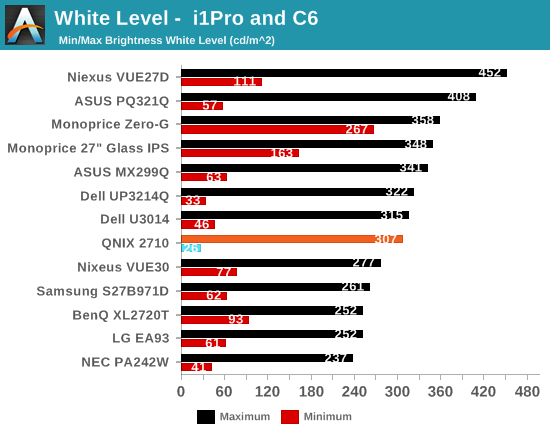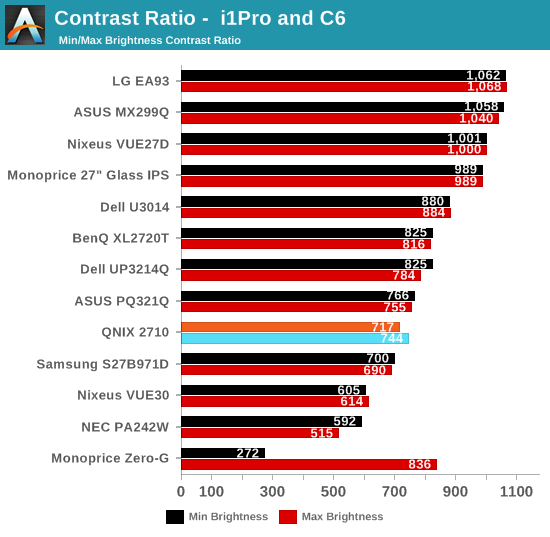QNIX QX2710 LED DPmulti True10 Review
by Chris Heinonen on April 11, 2014 6:00 AM ESTBrightness and Contrast
As I mentioned, I am not using the dynamic contrast feature for any of these measurements. Since it does not allow you to adjust the brightness when it is enabled, it will be far too bright for regular use and seems designed to mostly produce a number that looks good on spec sheets. In use it also takes nearly 3 seconds to respond to a change in average picture level, which most people will find too slow and annoying in actual use.
When the backlight is set to the maximum, a white field puts out 307 cd/m2 of light. Setting the backlight to minimum causes the white reading to fall down to 26 cd/m2. While the backlight setting is adjustable from 0-100, it is only adjustable in increments of 3, so it is really 0-33. These coarse adjustments cause issues later on as hitting 200 cd/m2 is a bit harder.

The black level with the backlight at maximum is a rather high 0.4122 cd/m2 and with it at minimum it is 0.0369 cd/m2. While the AUO panel used is AHVA, this is really more of an IPS type panel as opposed to being a VA type panel. AHVA (Advanced Hyper-Viewing Angle) is fundamentally different than VA (Vertical Alignment), and PVA/MVA panels would generally show much better black levels than this.

These combine to have mediocre contrast ratios of 717:1 and 744:1. Modern IPS panels are now doing over 1,000:1 and VA panels can be past 4,000:1. Since this is the first AHVA panel I’ve seen I’m not sure if this is an overall flaw with the AHVA technology or with the implementation in this monitor -- or perhaps a bit of both.

The QNIX is plenty bright and offers a nice lower level brightness setting as well. The rest of the brightness settings are too coarse to easily select a specific level, while the black level and contrast ratios suffer overall. In short, this isn't a professional grade display, but then the pricing and source should have already made that abundantly clear.










85 Comments
View All Comments
pierrot - Sunday, April 13, 2014 - link
Aw man, thanks for the reply though!Badelhas - Monday, April 14, 2014 - link
I have a QNIX QX2710 (normal one, with dual DVI only connection) and it dosent skip any frames at 120Mhz, I also did the test myself. I totally recommend it for gaming.I think AnandTech should not be cheap and spend 300 bucks and review that one. The one´s with multiple connections dont OC well.
Badelhas - Monday, April 14, 2014 - link
Please check this forum http://www.overclock.net/t/1384767/official-the-qn...eikast - Monday, April 14, 2014 - link
I am extremely disappointed due to this article.First of all the korean monitors (eBay) are not meant for professional usage. They're meant for gamers who want a reliable 2560x1440 monitor.
Second of all, you don't purchase the multi input version for gaming. They're horrible at overclocking and have more input lag. The version that only comes with one input (dual DVI) is what should be purchased. I paid $300 for my Xstar (same panel) with single dual DVI back in October. I had zero dead pixels, minimal lightbleeding and am able to OC it to 96 Hz without frame skips.
I love Anandtech because usually when i come here to see reviews I see good reviews from people who do their research. I made an account just so that I could post this comment.
If you are thinking about purchasing a korean monitor be sure to check out this link.
http://www.overclock.net/t/1384767/official-the-qn...
Much more useful than this article.
By the way, who the hell OCs a monitor to 110 Hz without trying other frequencies?
You start in increments and then you up the refresh rate.
milkod2001 - Monday, April 14, 2014 - link
im a bit confused with AHVA panel. Is it something new? Is it better then IPS/PLS?I wouldn't mind to pay 50xtra for proper stand with all tilt/shift options something like Dell has and another 50xtra for factory calibrated screen. Pity none of these cheapos have this options. If I'm mistaken plz post a link.
vgu - Tuesday, April 15, 2014 - link
I think the reason that this screen isn't capable of overclocking is because it has lots of processing in order to use DP and the menu system.I own the Qnix QX2710 with Dual Link DVI input only, and it overclocks to 120hz without a hitch. Used the same test as author to verify results.
However, I agree about the colors looking washed out compared to my Dell Ultrasharp.
yasamoka - Tuesday, April 15, 2014 - link
Use a color profile. At 120Hz there is quite the gamma shift.lang15 - Tuesday, April 15, 2014 - link
You picked one of the versions that does not overclock. The single input models (DVI-D only) CAN overclock easily. Is there anyway you can update the article concerning overclocking using one of these models? Any of these models that have more than one input will not overclock.okashira - Tuesday, April 15, 2014 - link
Not to mention has inferior contrast, colors and input lag.The "regular" QX2710 and DP2710LED are some of the best monitors on the market, period. They offer a combo of features that NO other monitors offer at ANY price point:
amazing colors
Good contrast for IPS type display
zero input lag
overclockable
great view angle
non-pwm dimming
Scannall - Wednesday, April 16, 2014 - link
I purchased a Qnix monitor a couple of years ago now. It was $285 delivered. And it has been great. I guess I won the panel lottery or something as there are no dead pixels, minimal backlight bleed and the color is uniform across the screen. It just has the Dual DVI input, which I don't mind but others may find bothersome.There is some element of risk buying these I suppose. With Apple or Dell, you know you will get prompt service or replacement if you're unhappy. But saving $700 made it a gamble I was willing to make.